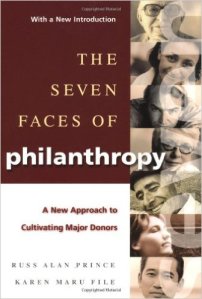While it is well established that Baby Boomer donors currently are in the prime charitable giving years, the fact of the matter is Millennial donors are becoming a force with which non-profits must reckon. So, I’ve asked Zach Hagopian from Accelevents to weigh-in with his suggestions on how your organization should start thinking about acquisition and retention of this new powerhouse generation of philanthripists. I think you will like his four suggestions. Here’s to your health! ~Erik
4 Ways to Acquire and Retain Millennial Donors
By Zach Hagopian
Co-founder & COO of Accelevents
 Is your nonprofit organization trying to break into the millennial space in order acquire and retain more millennial donors?
Is your nonprofit organization trying to break into the millennial space in order acquire and retain more millennial donors?
In this post, I am going to outline some of our most useful tips for both acquiring and retaining millennial donors.
But first, let’s discuss why millennial donors are so valuable…
According to the 2015 Millennial Impact Report, a whopping 84% of millennials made a charitable donation in 2014. Long gone are the days of assuming millennials are a predominantly selfish group of consumers.
While we can all agree that capturing millennial donors is immensely valuable for your nonprofit organization (or just for your annual fundraising event), many NPOs and fundraisers struggle to acquire and retain these donors.
Here are four of my best tips for acquiring and retaining millennial donors.
1. Get Personal
Our first tip is to get personal with your potential donors – tell the story of your cause and how it personally relates to your experience.
While inclined to donate, millennials constantly seek stories that they can identify with. Affinity in values and social responsibility are extremely important, when it comes to the restaurants millennials eat at, the stores they shop at, and even the organizations they donate to.
Conveying your story in a meaningful way will get you in the door with millennials, and the rest will be history (if you follow our next three steps…)!
2. Utilize Technology
One thing that we can all agree on is that millennials are very connected.
Whether we are checking our iPhones every 30 seconds, or sneaking a look at our Facebook news feed during a conference call, we millennials have the means to find and share any information instantly.
And fundraisers / nonprofits should be using this to their advantage!
In today’s world, millennials are willing to donate to charitable causes, but they desire to do so on their terms, which means embracing easy-to-use, flexible, and accessible donation tools. For the most part, this entails making the switch from traditional means to online and mobile enabled platforms.
These tools can be anything from donation pages to mobile silent auctions and raffles and peer-to-peer fundraising campaigns.
Regardless of the tools you decide to move forward with, embracing technology will allow you to offer millennials a much easier channel for them to donate whenever they’d like.
3. Embrace FOMO
Our next tip if for your organization to embrace one of the strongest emotions felt among millennials – THE FEAR OF MISSING OUT (aka “FOMO”).
When used with online and social fundraising methods, FOMO can become one of your best tools for millennial acquisition AND retention.
The key here is to hold your donors socially accountable. Did your supporters just buy a ticket to your next fundraising event? Has one of your donors just made a donation to support your cause? Provide them a means to share this to their social network!
When your donors share updates about your cause, the benefits here are twofold:
- Acquisition – Other millennials will witness all of the passion and excitement around supporting your cause, and will flock to join. Just like that, you’ve acquired new millennial donors.
- Retention – Your current supporters may not have returned to support your cause for a second time. FOMO comes to the rescue, reminding them that they too should be joining in the excitement of helping a great cause.
4. Show Your Appreciation (with a twist!)
While our final tip applies to donors of all ages, it is still extremely important for your millennial donors. As most people do, millennials appreciate being acknowledged for their support and contribution to your cause.
Traditional methods of thanking your millennial donors work great, but your thank-yous are even more effective when you can add a twist!
Some of our favorite examples of unique acknowledgements for millennials include:
- Donor Spotlights – Has one of your donors (or a group of donors) gone above and beyond in their support of your cause? If so, create a nice piece of content on their story, and share this out to your audience. Not only will the highlighted donor(s) feel appreciated, but your other supporters will see the lengths that your team goes to, in order to acknowledge your donors
- Create a Sizzle Reel – Did you just wrap up a great fundraising event or have your best year in terms of donations? Spend some resources to create a great video or “sizzle reel” to share with your audience. An exciting video will stand out against the hundreds of emails your audience receives each day, and it’s also a great piece of content for your donors to share out to their networks!
About the Author
 Zach Hagopian is the co-founder and COO of Accelevents, a mobile fundraising platform that enhances silent auctions and raffles through online and text-message bidding. An active member in the Boston fundraising scene, Zach focuses on improving traditional fundraising methods and increasing fundraiser proceeds.
Zach Hagopian is the co-founder and COO of Accelevents, a mobile fundraising platform that enhances silent auctions and raffles through online and text-message bidding. An active member in the Boston fundraising scene, Zach focuses on improving traditional fundraising methods and increasing fundraiser proceeds.
As a Millennial living in Boston with strong ties to the Boston fundraising community, Zach most recently spent the past two years organizing a fundraiser geared almost completely to millennial donors. In his first year, they attracted 850 guests to their event and raised over $65,000 for the prestigious Dana-Farber Cancer Institute. In year two, they raised $108,000 from over 1,000 Boston-area millennials and young professionals.

 Earlier this week and last week, I started writing about the State of Illinois’ budget crisis and how it is impacting non-profit organizations. In
Earlier this week and last week, I started writing about the State of Illinois’ budget crisis and how it is impacting non-profit organizations. In  Don’t want to take my word for it because you might have heard it from your grandfather or another beloved family member. No problem … I completely understand. Let me provide you with scientific proof. Simply
Don’t want to take my word for it because you might have heard it from your grandfather or another beloved family member. No problem … I completely understand. Let me provide you with scientific proof. Simply  Your board is likely made up of smart people. If they aren’t being used (at a minimum) as a “sounding board” on the issue of government funding and what to do about it, then my suggestions are:
Your board is likely made up of smart people. If they aren’t being used (at a minimum) as a “sounding board” on the issue of government funding and what to do about it, then my suggestions are: Of course, the more difficult question for most non-profit organizations is “What to do about it?”
Of course, the more difficult question for most non-profit organizations is “What to do about it?”
 Here is what I didn’t expect to hear:
Here is what I didn’t expect to hear: Believe it or not, this phenomenon has a name. It is called the
Believe it or not, this phenomenon has a name. It is called the  One of my favorite movie scenes is at the
One of my favorite movie scenes is at the  You have lots of short-term options that will help bridge your organization through a cash flow crisis. The following is a short list of some of those options:
You have lots of short-term options that will help bridge your organization through a cash flow crisis. The following is a short list of some of those options: If I’ve seen it once, I’ve seen it a number of times . . . board volunteers want to hold someone accountable after the crisis passes. In my opinion, the best way to survive this dynamic is to be able to point to:
If I’ve seen it once, I’ve seen it a number of times . . . board volunteers want to hold someone accountable after the crisis passes. In my opinion, the best way to survive this dynamic is to be able to point to: Now that you’ve made it through the crisis and have a firm understanding of what caused it, it is important have a new long-term plan that keeps you from ending up back from where you just came.
Now that you’ve made it through the crisis and have a firm understanding of what caused it, it is important have a new long-term plan that keeps you from ending up back from where you just came. Your nonprofit is constantly trying to improve. Whether you’re developing an efficiency hack for your staff members or trying new fundraising events, openness to change is what allows your organization to grow, acquire more donors, and raise more money for your cause.
Your nonprofit is constantly trying to improve. Whether you’re developing an efficiency hack for your staff members or trying new fundraising events, openness to change is what allows your organization to grow, acquire more donors, and raise more money for your cause. Abby Jarvis is a blogger, marketer, and communications coordinator for
Abby Jarvis is a blogger, marketer, and communications coordinator for  Well, it happened to me and my husband again just the other day. We were asked to dinner by a non-profit friend. It was a simple dinner invitation, and one that we’ve been working on setting up for more than a year. We weren’t in the restaurant for more than 15 minutes and the pre-meal cocktails had just arrived, when our friend was asking us to give some consideration to making a contribution to their organization’s endowment fund.
Well, it happened to me and my husband again just the other day. We were asked to dinner by a non-profit friend. It was a simple dinner invitation, and one that we’ve been working on setting up for more than a year. We weren’t in the restaurant for more than 15 minutes and the pre-meal cocktails had just arrived, when our friend was asking us to give some consideration to making a contribution to their organization’s endowment fund. Simply, I believe soliciting unsuspecting prospects and donors is detrimental to your organization (and to everyone else in non-profit sector) for the following reasons:
Simply, I believe soliciting unsuspecting prospects and donors is detrimental to your organization (and to everyone else in non-profit sector) for the following reasons: In an effort to do may part to help eradicate the “ambush” tactic from our non-profit toolbox, I will share with you some of the tips from this video.
In an effort to do may part to help eradicate the “ambush” tactic from our non-profit toolbox, I will share with you some of the tips from this video. It was a bleary-eyed late night dash in a rental car to position myself for a morning meeting, and I was listening to National Public Radio (NPR) in an effort to stay awake. At one point, someone was interviewing iconic feminist leader Gloria Steinem. While I cannot remember the big reason for the interview (e.g. new book, rally, election analysis, court ruling, etc), there was one thing that stuck with me, and I just had to share with you because I think it is a great allegory for how your non-profit should interact with donors.
It was a bleary-eyed late night dash in a rental car to position myself for a morning meeting, and I was listening to National Public Radio (NPR) in an effort to stay awake. At one point, someone was interviewing iconic feminist leader Gloria Steinem. While I cannot remember the big reason for the interview (e.g. new book, rally, election analysis, court ruling, etc), there was one thing that stuck with me, and I just had to share with you because I think it is a great allegory for how your non-profit should interact with donors. For me, sometimes people speak the truth and it hits me in such a way that I have a hard time getting it out of my head. It rolls around like a pinball in my brain, and the only way for me to stop the experience is to write about it. Well, this happened again on January 28, 2016 at approximately 10:15 pm while I was watching a Special Edition of Hardball with Chris Matthews. It occurred during an interview with Mike Huckabee, when the former presidential candidate said something close to the following (and if memory serves me correctly, I think it was in response to a question about the primary election system):
For me, sometimes people speak the truth and it hits me in such a way that I have a hard time getting it out of my head. It rolls around like a pinball in my brain, and the only way for me to stop the experience is to write about it. Well, this happened again on January 28, 2016 at approximately 10:15 pm while I was watching a Special Edition of Hardball with Chris Matthews. It occurred during an interview with Mike Huckabee, when the former presidential candidate said something close to the following (and if memory serves me correctly, I think it was in response to a question about the primary election system):